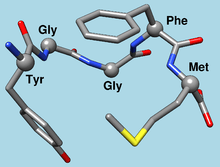Enkephalin
An enkephalin is a pentapeptide involved in regulating nociception in the body. The enkephalins are termed endogenous ligands, as they are internally derived and bind to the body's opioid receptors. Discovered in 1975, two forms of enkephalin have been found, one containing leucine ("leu"), and the other containing methionine ("met"). Both are products of the proenkephalin gene.[2]
- Met-enkephalin is Tyr-Gly-Gly-Phe-Met.
- Leu-enkephalin has Tyr-Gly-Gly-Phe-Leu.
 Met-enkephalin 3D structure, alpha-carbons shown as balls and labeled by residue.[1] | |
| Identifiers | |
|---|---|
| Symbol | PENK |
| NCBI gene | 5179 |
| HGNC | 8831 |
| OMIM | 131330 |
| RefSeq | NM_006211 |
| UniProt | P01210 |
| Other data | |
| Locus | Chr. 8 q23-q24 |
Endogenous opioid peptides
There are three well-characterized families of opioid peptides produced by the body: enkephalins, B-endorphin, and dynorphins. The met-enkephalin peptide sequence is coded for by the enkephalin gene; the leu-enkephalin peptide sequence is coded for by both the enkephalin gene and the dynorphin gene.[3] The proopiomelanocortin gene (POMC) also contains the met-enkephalin sequence on the N-terminus of beta-endorphin, but the endorphin peptide is not processed into enkephalin.
Effects on stress
Enkephalin is also considered a neuropeptide, which in the human body performs as an important signaling molecule in the brain. Enkephalins are found in high concentration in the brain as well as in the cells of adrenal medulla. In response to pain, norepinephrine, a hormone that is activated in fight-or-flight response is released along with endorphins.[4] It has been shown that this polypeptide is linked to brain functioning during a stressful response, especially in the hippocampus and prefrontal cortex regions. During a stress response, several Met-enkephalin analogs had increased activity in the hippocampus, while Leu-enkephalin analogs as well as somatostatins were downregulated during stress. This observation leads to a conclusion that stressors impact neuropeptides, and that their action is localized to a specific brain region.[5]
Enkephalin receptor
The receptors for enkephalin are the delta opioid receptors and mu opioid receptors. Opioid receptors are a group of G-protein-coupled receptors, with other opioids as ligands as well. The other endogenous opioids are dynorphins (that bind to kappa receptors), endorphins (mu receptors), endomorphins, and nociceptin/orphanin FQ. The opioid receptors are ~40% identical to somatostatin receptors (SSTRs).
See also
References
- PDB: 1plx; Marcotte I, Separovic F, Auger M, Gagné SM (March 2004). "A multidimensional 1H NMR investigation of the conformation of methionine-enkephalin in fast-tumbling bicelles". Biophys. J. 86 (3): 1587–600. Bibcode:2004BpJ....86.1587M. doi:10.1016/S0006-3495(04)74226-5. PMC 1303993. PMID 14990485.
- Noda M, Teranishi Y, Takahashi H, Toyosato M, Notake M, Nakanishi S, Numa S (June 1982). "Isolation and structural organization of the human preproenkephalin gene". Nature. 297 (5865): 431–4. Bibcode:1982Natur.297..431N. doi:10.1038/297431a0. PMID 6281660.
- Opioid peptides: Molecular pharmacology, biosynthesis and analysis, R.S. Rapaka and R. L. Hawks (editors) in a National Institute on Drug Abuse Research Monograph (#70), 1986.
- Pasternak GW. "Endorphins". AccessScience. doi:10.1036/1097-8542.232500.
- Henry MS, Gendron L, Tremblay ME, Drolet G (2017). "Enkephalins: Endogenous Analgesics with an Emerging Role in Stress Resilience". review. Neural Plasticity. 2017: 1546125. doi:10.1155/2017/1546125. PMC 5525068. PMID 28781901.
External links
- Enkephalins at the US National Library of Medicine Medical Subject Headings (MeSH)
- Nosek, Thomas M. "Section 6/6ch2/s6ch2_36". Essentials of Human Physiology. Archived from the original on 2016-03-24.